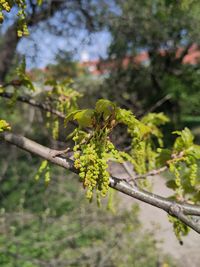Issued on April 24, 2025
It remains unsettled with a fluctuating pollen load!
Days of changeable weather await us. The rain provides pollen allergy sufferers with some relief. As soon as the sun comes out again and the flowers dry out, the pollen count can rise again to moderate to high levels. Pollen allergy sufferers must therefore be prepared for a fluctuating pollen load.
The higher elevations of the Limestone Alps and the Waldviertel are currently still the areas where birch, hornbeam and ash are still flowering and dusting. With the right wind currents, pollen can be transported from here to the lowlands and cause pollution there. In the Weinviertel, along the Danube and in the Vienna Basin, these three allergenic trees have already finished flowering.
The oaks, beeches and walnuts, which are now in full bloom, are also important for people who are sensitized to birch trees. Because they are related to the birch family, their pollen can cause cross-reactions.
For allergy sufferers who are sensitive to olive trees , there are currently two flowering ornamental trees, namely the lilac and the manna ash. Both are insect-pollinated and therefore produce smaller amounts of pollen than the common ash. However, sensitized persons should avoid the immediate vicinity of or direct contact with these plants.
In addition to the plants mentioned above, the plane tree also blooms in residential areas. It is often planted as an avenue and park tree and can cause additional exposure in sensitized persons.
Rape is beginning to flower in the fields. This can cause allergic reactions in people who are sensitized to cruciferous plants.
The first flowering grasses have been reported in isolated cases. These can locally affect people who are sensitized to grasses. According to the flowering readiness model, the widespread flowering of grasses is expected at the beginning of May. Dock also begins to bloom and causes additional exposure.
The white flakes that can already be seen sporadically in the air are poplar absorbent cotton. It cannot cause allergic reactions as it is not pollen but poplar seeds and seed hairs. The flight of poplar absorbent cotton usually coincides with the start of flowering of the grasses.
Ambient air: maple, boxwood, poplar, sour grasses, horse chestnut, roses, willow and cypress. These are of minor allergological importance.
| Flowering grasses | at the |
|---|---|
Allentsteig | 12.05.2025 |
Amstetten | 03.05.2025 |
Gumpoldskirchen | 02.05.2025 |
Gutenstein-Mariahilfberg | 08.05.2025 |
Hohe Wand | 15.05.2025 |
Krems | 02.05.2025 |
Lunz am See | 08.05.2025 |
Reichenau an der Rax | 05.05.2025 |
St. Pölten | 02.05.2025 |
Tulln/Langenlebarn | 01.05.2025 |
Waidhofen an der Ybbs | 02.05.2025 |
Wiener Neustadt | 02.05.2025 |
Zwerndorf-Marchegg | 01.05.2025 |
Forecast from 24.04.2025
Note: The data shown here are model data for the expected start of flowering. For more detailed information on the expected pollen count, please refer to the text forecasts.
Responsible for the content
AZ Pollenresearch GmbH im Auftrag der Niederösterreichischen Landesregierung, Gruppe Gesundheit und Soziales, Abteilung Umwelthygiene.
Dr. rer. nat. Johannes M. Bouchal, Lukas Dirr, MSc und Mag. Sabine Kottik.
Wetterdaten und Prognosen basierend auf synoptischen Daten:
GeoSphere Austria, Bundesanstalt für Geologie, Geophysik, Klimatologie und Meteorologie (ehemals ZAMG).
zum Team


